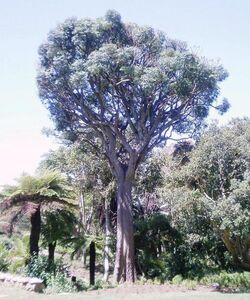Biology:Cussonia spicata
| Spiked cabbage tree | |
|---|---|

| |
| Cussonia spicata | |
| Scientific classification | |
| Script error: No such module "Taxobox ranks".: | Plantae |
| Script error: No such module "Taxobox ranks".: | Tracheophytes |
| Script error: No such module "Taxobox ranks".: | Angiosperms |
| Script error: No such module "Taxobox ranks".: | Eudicots |
| Script error: No such module "Taxobox ranks".: | Asterids |
| Script error: No such module "Taxobox ranks".: | Apiales |
| Script error: No such module "Taxobox ranks".: | Araliaceae |
| Script error: No such module "Taxobox ranks".: | Cussonia |
| Script error: No such module "Taxobox ranks".: | <div style="display:inline" class="script error: no such module "taxobox ranks".">C. spicata |
| Binomial name | |
| Cussonia spicata | |
Cussonia spicata, known as spiked cabbage tree, lowveld cabbage tree or common cabbage tree, is a tree in the family Araliaceae, which is native to the moister regions of Sub-Saharan Africa. It is cultivated as a garden plant in areas without extreme degrees of frost. It is one of the favorite foods of wild elephants.[1]
Description
Larger specimens develop a sturdy trunk and a rounded, spreading canopy, and can reach a height of 15 meters. The attractive leaves grow from the end of thick branches to form rounded heads. The species name spicata means "spike-like", and suggests the arrangement of its flowers.[2]
Range
It occurs naturally from southern and eastern South Africa to the Eastern Highlands of Zimbabwe, Mozambique, Zambia and northwards into tropical Africa.[2]
Ethnomedical uses
It has been used in traditional African medicine and its medicinal properties are being investigated.
- A bark decoction is used in the treatment of malaria, and indigestion in a similar manner to tonic water
- A root decoction is used to treat fever, venereal disease, as well as a diuretic and laxative.
- A root bark decoction is used to treat mental illness.
References
- ↑ Minute 6-7; April 5, 2009 episode)Naked Scientists
- ↑ 2.0 2.1 Hankey, Andrew (December 2004). "Cussonia spicata Thunb.". SANBI. http://www.plantzafrica.com/plantcd/cussonspic.htm.
External links
Wikidata ☰ Q5196278 entry
 |
